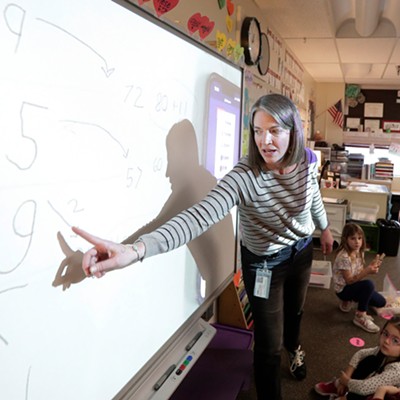
Katie Campbell points to a mishmash of equations, discussing domains, quotients and sums of functions.
“Does everybody agree?” she asks. “Does everyone know where this came from?” Campbell is a 29-year-old graduate student teaching Math 114, an algebra course, at Eastern Washington University. Her students, some looking blearily ahead, others scrawling in notebooks, mumble their assent.
At least, the ones who showed up do. Eleven students — one-third of the class — are missing. Last spring, over 60 percent of the students either withdrew or received grades too low for college credit. Of the 138 who took the class, only 54 received a grade higher than a “D.” Not a single student received an “A.”
That’s not uncommon. Whether because of unprepared students or insufficient teaching, only about half of the Eastern students who take lower-level math classes pass them. The math department’s average GPA is below a 2.0 — the equivalent of a C. Math classes at Eastern are graded on a 4.0 scale, and almost every class requires at least a 2.0 to pass.
And yet, struggling classes are often taught by graduate students with less teaching experience than a first-year high school teacher. Eastern has tried a number of ways to improve passing rates, with little result. Now, with the use of graduate students to teach low-level classes coming under criticism, Eastern’s provost and president have decided to implement a drastic plan: They’re entirely eliminating the area’s only mathematics graduate program.
Amy Meyer, the student editor-in-chief of the Easterner student newspaper, has been investigating the math program for months. She’d long heard complaints. Dismal reviews at ratemyprofessor.com inspired her to request public records for math-class passing rates.
“I could understand one or two slipping through the cracks,” Meyer says. “But to have numbers in general that low?”
Subsequent Easterner articles — one negatively comparing Eastern’s passing rates to those at a number of community colleges — drew several critical emails from math department chair Barbara Alvin. She accused Meyer of drawing unfair comparisons, and of being biased against the math department because of her daughter’s trouble with Eastern’s math courses. But Meyer scoffs at these accusations. Her daughter passed both her classes with grades equivalent to a B. It’s the passing rates, Meyer says, that have her worried.
“In fall 2009, 38
percent of the students that attempted Math 104 [Intermediate Algebra]
passed with a 2.0 or better,” Meyer says. “That’s kinda why I’m not
letting go of it.”
Alvin's office in Eastern’s Kingston Hall is piled high with papers. The gray-haired mathematics department chair slides across her desk a sheet showing math SAT scores of college students admitted to Washington’s universities.
Eastern has the lowest. By comparison, three-fourths of University of Washington students came in with SAT scores as good as the top fourth of Eastern students.
Two years ago, only 41 percent of Washington’s 10th graders passed the state standardized math test. Compounding matters, Alvin says, Eastern uses a math placement test with multiple-choice questions that only offer three choices. Students may be guessing their way into math classes too difficult for them.
Across the hall, Jane Lane, another EWU math instructor, says she’s saved an actual pile of reasons her students give for how they got through high school math.
“The majority were based on factors that have nothing to do with the math,” she says. The students did extra credit. Their teacher dropped their lowest test grade. They cheated. Their mom came in and talked to the teacher. On top of all that, college math is much faster — a year of high-school math is often crammed into 10 weeks in college.
“I don’t think we’ve always been cognizant that students don’t know how to study,” Alvin says.
Teachers at Eastern assign “practice questions,” specific homework problems they won’t be graded on but that cover skills crucial for surviving tests. But Alvin says many students don’t do them. She points them toward the tutoring lab, open every weekday, but says many students wait until the end the quarter, when it’s too late.
Michael Hurley, a facilitator who helps Lane teach Math 104, says the teaching is fantastic. It’s just that some students are lazy.
“It was very obvious to me,” Hurley says sarcastically, “that what’s broken with the Eastern Washington math program is they don’t actually go to [the students’] dorm rooms and help them with homework.”
On most Fridays, Lane says, about a third of her students skip class.
“I’m horrified,” she says of the failure rate. “I wish I could tell you how hard we work at it — every couple years, we’ve tried something different.”
The department has created teaching courses to train graduate students. It split both Math 103 and 104 into two separate “modules,” requiring students who only failed half the course to retake that half. It siphoned off the advanced content of Math 104 to create Math 114. It began to ask graduate students to assist with large lecture courses taught by regular faculty members.
Yet progress has been halting. In her office, Alvin hands over a photocopy of an article interviewing Paul Nolting, an instructor at the University of South Florida. He’s an expert on failure rates for low-level math courses, having helped 100 different colleges with their math troubles. Fifty-percent failure rates in college basic-math classes are common, he says. And since many schools require multiple math classes, those problems can turn frustrated students into college dropouts.
Teachers, he says, need to explain math skills in multiple ways for different types of learners. And for some majors, Nolting suggests changing graduation requirements — requiring statistics or logic instead.
“Not everyone needs college algebra,” Nolting says.
“I have friends and colleagues and an ex-wife that are nurses. And they never use it.”
Many Eastern students blame graduate students. In the Eastern math lab, Jacob Hammon pours over the Math 114 curriculum with a tutor. Hammon, a construction technology student, was among the 60 percent who failed Math 114 last semester. That wasn’t the first math class he’s failed. He says he and other students have trouble with the way graduate students teach.
“I just find that a lot of people, after he explains a problem, have a blank stare,” Hammon says about one graduate student. “Unless you want to raise your hand every time, after each problem, it would be embarrassing.”
Other students say grad students are more concerned with getting their own degrees than teaching, or that they only explain a problem in one way.
Outside of the small office he shares with another grad student, Ryan Downie says he was nervous when he, at 26, taught his first EWU math class. One quarter he took a teaching course and assisted in Math 104. The next quarter he was asked to teach a crowd of struggling college math students. (“That’s better than we used to do,” Alvin says. “We used to throw them to the wolves right away.”) Downie says he felt prepared to teach the class. But he also says the failure rate was disheartening.
“Am I missing something as far as how I’m teaching?” Downie wonders about the often-low pass rates.
But he also sees other factors. “I look out and see students texting during class or reading other books.”
Some students have used a workaround: When Hammon didn’t pass Math 104, he took it at a community college. There, he got a B . Several Eastern students say that, after failing a math course one or two times, they easily passed at a community college.
At Spokane Falls Community College, most of the math faculty have over 15 years of experience, says professor Mike Dirks, who teaches an SFCC algebra course equivalent to Eastern’s Math 114.
“We’re used to the errors that students make,” Dirks says. “The way students think about things. There’s the logic of math, and there’s the psychology of math.”
In most of his classes, Dirks says, at least 75 percent of the students pass. Alvin argues that the community colleges’ greater breadth of low-level classes allows more flexibility to accurately place struggling students.
Both of Spokane’s community colleges and Central Washington University generally have higher passing rates than many of Eastern’s low-level math courses. During spring quarter of 2011, just 37 percent of Eastern math students passed with a 2.0 or better. But at Spokane Community Colleges, over 60 percent of the students in the equivalent course got a C or above.
Of these schools, only Eastern employs graduate students as teachers.
Eastern's math department proposed a solution. In October, the department suggested hiring three more instructors. Grad students in Math 103 and 104 would assist the instructor, instead of teaching solo.
But this November, Provost Rex Fuller gave a different recommendation: Get rid of mathematics graduate students entirely. The university president agreed.
Unless the president’s mind changes in the coming months, the university will gradually begin to eliminate the master’s degree in mathematics.
The low number of mathematics graduate students was the primary reason for his recommendation, the provost says. But the consistently low passing rates also played a part.
“There are campuses nationwide where the [passing rates] are higher,” Fuller says. “One can speculate if you have relatively inexperienced faculty teaching students who have had the most difficulty with math, you may not get very positive results.”
Professors who taught for the master’s program could teach other courses, he says, letting experienced faculty teach struggling students.
But department chair Alvin says the university president has failed to do the math. She says he doesn’t understand — or hasn’t taken the time to understand — that replacing graduate students with instructors will cost at least $150,000 more a year. And ultimately, she says, it won’t stop students from failing. To her, the problems with university math begin much earlier.
“We’re admitting students who aren’t prepared to succeed,” Alvin says. “We’re encouraging them to take out loans and get into debt, and they’re not prepared.”

























